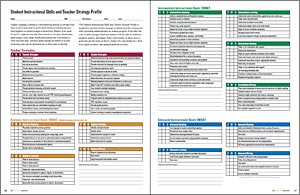
Help students express their ideas and build vocabulary, and move from beginner to advanced levels of acquisition.

English Language Learning is a developmental process. It can take up to seven years for an ELL to reach native proficiency, as they proceed through three identifiable levels. Each stage of English language acquisition presents unique challenges and requires unique strategies to ensure students progress and develop native proficiency.
Approaching these stages in the most authentic and natural ways possible will be most helpful in your classroom. A parent would not expect their child to learn to speak by writing “Daddy” on a whiteboard. Infants learn words in context, seeing, hearing, and even smelling the object that corresponds to this new word. Similarly, allowing ELL students to acquire new vocabulary in context will aid them in their progression toward English mastery.
Pixie provides many ways for students to use words in context, express their ideas, build vocabulary, follow directions, and practice using words and their proper meaning, helping them move from beginner to advanced levels of acquisition.

A beginner ranges from the newcomer, or low–beginner, who is adjusting to a new environment, to a high–beginner who has already acquired Basic Interpersonal Communication Skills (BICS) or social language. Even though the newcomer may not yet be speaking English, they are exposed to the second language from day one.
Focusing on language arts and thematic teaching during the beginning stages is most helpful. This provides opportunities to repeat the same words in context. Using visuals to develop vocabulary is of the utmost importance. Combining Pixie’s paint tools with its extensive image library can help students build new vocabulary, allowing them to communicate understanding without worrying about a new language.
Engaging a newcomer can be difficult. Limited understanding of the new language makes them very reliant on their visual strengths and the kindness of those around them. The low-beginner:
At this stage, Pixie can help you communicate and differentiate by providing tools you can use to create talking pictures to develop and reinforce vocabulary. Have students use the talking pictures you develop, both independently and with buddies, to reinforce learning while the rest of the class is involved in other activities. Depending on their background and grade level, you may also want to show your ELLs how to launch Pixie and open a talking picture on their own. If you do not have a computer for each student, use the Print options to create handouts.
The mid-beginner ELL has made some adjustments to his or her new environment. However, communicating with peers and teachers remains frustrating. The mid-beginner:
Use the following strategies, along with those you’ve been using for the low-beginner ELL, to engage mid-beginners:
The high-beginner ELL has developed a solid social vocabulary. While he or she may appear to show more interest in learning, academic vocabulary remains challenging. This stage may last up to two years before the student is ready to develop and use academic vocabulary. Learning a language and learning in a language require different levels of acquisition. The high–beginner:
Add these strategies to those described above, especially once you begin to introduce more academic vocabulary.
At this stage, there are no limits to the ways you can use Pixie to enrich the vocabulary development of the ELL as well as enrich the learning of the native speakers in your classroom. Differentiation enables your teaching to connect with more of your students. One way to differentiate a lesson to reach more learners is to provide choices for how a project can be completed. For example, you might suggest students use a variety of graphic organizers in the Language Arts activity folders when retelling stories.

The intermediate ELL is becoming much more responsible for their own learning. This stage can last between one to three years before the ELL moves closer to peer-level proficiency. The intermediate ELL:
Add these strategies to the ones you have been using for the beginner ELL:
Teachers and students can use the tools and features in Pixie to build vocabulary. Students can use the graphic organizers and activities for self expression and to share knowledge.
The advanced ELL is nearing grade-level expectations, and you will see more rapid learning. While an ELL student at this stage has acquired an expressive vocabulary of 3,000–4,000 words, remember that their peers generally have a significantly larger working English vocabulary. An average fifth grader, for example, has a working vocabulary of about 10,000 words.
While reading and writing comprehension is stronger, the demands of grade level academics will remain challenging for one to three more years. Now is the time to infuse activities with higher-level thinking skills, such as comparing, evaluating, extrapolating, and synthesizing. The advanced ELL:
All ELL strategies are still appropriate, but you can now employ these techniques in different ways:
Pixie’s paint tools, stickers, and the option to import additional images is helpful even at this stage, since the ELL’s verbal expression can be misleading when it comes to academics. Graphic organizers of all kinds also continue to support learning for the advanced ELL.

Follow us on Instagram for daily inspiration

Create a thought web, cluster, flowchart, or other graphic organizer for a lesson
Five ideas for creative classroom centers
Creative, digital book reviews
Fun and powerful ideas with animated characters

Wixie
Share your ideas, imagination, and understanding through writing, art, voice, and video.

Rubric Maker
Create custom rubrics for your classroom.

Pics4Learning
A curated, copyright-friendly image library that is safe and free for education.

Wriddle
Write, record, and illustrate a sentence.

Get creative classroom ideas delivered straight to your inbox once a month.
Topics